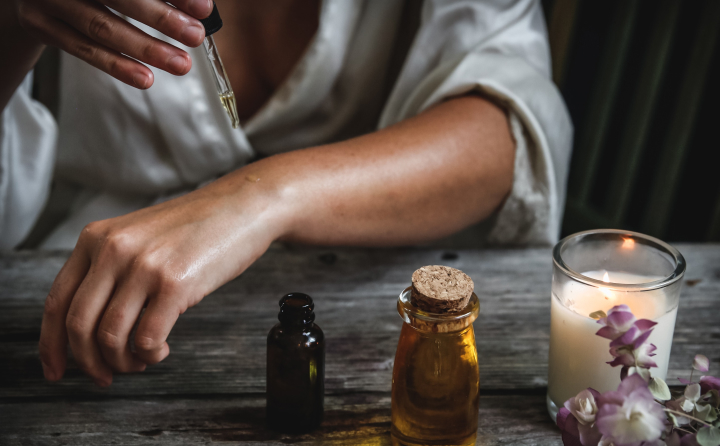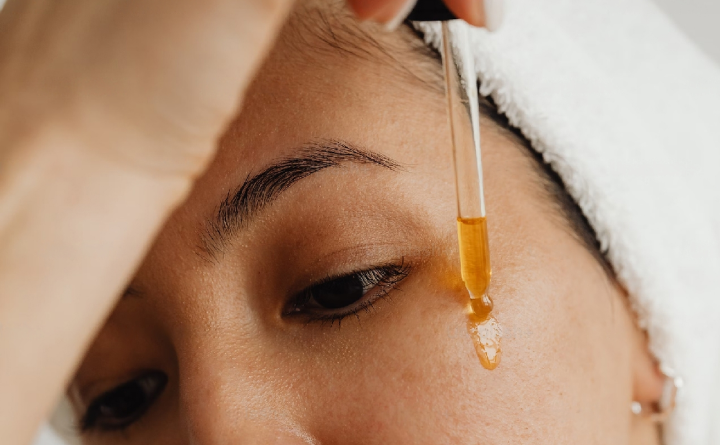How to dilute essential oils for topical use
.png)
Concentrated substances are seldom intended for direct use, and essential oils are no exception. Basically you should always dilute the power and concentration of an essential oil before applying it to the skin.
Dilution of essential oils is done by adding one drop (or more) of the essential oil in a carrier or vegetable oil, such as jojoba or almond oil, etc. This not only provides a good means for the oil to be absorbed into the skin, but it helps to spread the essential oil over a larger surface area.
Even essential oils that require extreme caution during direct and concentrated handling can be safely used once diluted correctly. Knowing how to properly dilute essential oils is essential to use them safely.
.png)

Proper dilution of essential oils provides a safety measure against topical irritation, sensitivity, photosensitivity, and sensitization (and allergies). Robert Tisserand tells us:
"Dilution of the essential oil is important for two safety reasons. One, to avoid skin reactions: irritation, sensitization, and phototoxicity. Two, to avoid systemic toxicity, such as fetotoxicity, hepatotoxicity, carcinogenicity, and neurotoxicity. "Adverse skin reactions are obvious when they occur, but systemic toxicities may not. Skin reactions are entirely dependent on dilution and there are safety guidelines to minimize the risk."
In other words: we dilute essential oils before applying them to the skin to minimize adverse reactions and avoid systemic toxicity.
Depends on several factors including, but not limited to:


Here are some general guidelines for diluting essential oils safely. Keep in mind that these are only general guidelines and that there may be other factors that invalidate them or to take into consideration.
Always use the lowest possible proportion of essential oils, that is, dilute them as much as possible as far as they provide effective results. Remember, you can dilute in a variety of carriers: lotions, oils, aloe vera gel, etc.
We recommend to totally avoid the use of essential oils for children under the age of 2. Instead use herbal medicine or natural hydrosols. The use of essential oils for babies must be prescribed or recommended by an experienced physician or certified aromatherapist. They use very small quantity and heavily diluted oils for the little ones, only in urgent situations, such as a bee sting or an insect bite, when no other options are available.
NEVER APPLY ESSENTIAL OILS TO BABIES WITHOUT CONSULTING A DOCTOR OR A CERTIFIED PROFESSIONAL
Babies are not ready for essential oils.
Total max 0.25% dilution.
(1 drop for 4 teaspoons of carrier oil.)
Hydrosols and herbs are still a good choice for this age group and should be considered before using essential oils. Children in this age group have somewhat thicker skin and their immune systems are maturing, so sometimes it is okay to use safe essential oils for kids (such as lavender). Avoid essential oils that contain phenols and ketones. Stick to a few safe for kids essential oils.
Total max 1% dilution (1 drop per teaspoon of carrier oil, 6 drops per 30 ml).
Recommended total max dilution for children over 6 years old, pregnant women, older adults, people with sensitive skin, compromised immune systems or other serious health problems. This is also the dilution necessary when applied to the face or massaged over a large area of the body. We usually recommend this dilution as a safe max standard.
3% to 10% dilution (2 to 20 drops per teaspoon of carrier oil, 12 to 120 drops per 30 ml)
Better to use in the short term for a temporary problem, such as a muscle injury or respiratory congestion. For an acute problem, such as muscle cramp or severe pain, 25% may be appropriate (25 drops per teaspoon of vegetable oil, 150 drops per 30 ml).
Essential oils are highly concentrated substances and must be diluted in almost all uses. Keep oils out of the reach of children and pets, locked in a cabinet if possible. Store the oils in a dark and cool place for better preservation.
Children from 2 to 6 years old. However, we do not encourage the use of essential oils at this age. For children better use flower waters or hydrosols. If you are a healthy adult who enjoys essential oils daily, you may find its benefits at this low percentage.
Less is more!
Children over 6 years old. Pregnant women*. Old people. People with sensitive skin, compromised immune systems, or other serious health conditions. This proportion is suitable to massage a large surface of the body.
* Application on pregnant women is recommended only from the fourth month onwards. Only use pregnancy safe essential and vegetable oils, avoid the rest. There are a few essential oils that may contain hepatotoxic, nephrotoxic or abortifacient molecules. They should be avoided.
Ideal for most adults in most circumstances, including daily care.
Used for short periods for temporary conditions such as muscle injuries, respiratory congestion. Even in some cases, depending on age and physical condition, dilution could reach a 10% of essential oil (although always better under the supervision of a certified professional).
Exclusive for very specific applications such as muscle cramps, bruises and severe pain. Use this extraordinary heavy dilution only under the guidance of a professional: not doing so involves the risk of skin chemical burn, toxicity and other risks that some dermocaustic oils pose undiluted (such as oregano).
Extreme caution is required when applying undiluted essential oils, as some people may experience irritation or allergies. Only a very few essential oils can be used like this, such as lavender, when it comes to treating insect bites, light burns or cramps in a timely manner.
A good carrier oil has ideal properties for both nourishing our skin and carrying and fixing essential oils. Among the most popular are almond oil, jojoba oil or wax for its high fixing power, rosehip oil, and shea butter, whose repairing and protective properties are well known.
Sometimes an essential oil can be used undiluted to treat acute problems in the very short term. A bug bite or burning could be a good reason to use an essential oil in this way. It must be done wisely and it should not become a habit. Some essential oils can not only irritate the skin, but increase the risk of sensitization and allergies.
The lower the amount of essential oil in the dilution, the lower the risk of adverse reactions. You must be stingy with dilutions. When it comes to essential oils, less is more.

Natural
All our products are completely natural and pure, undiluted.
We do not add synthetics or additives.

Certified
Manufacturing process endorsed by the EU.
One of the few that fully complies with current regulations.

Free Shipping
Free certified free shipping via 24-hour courier on purchases over 45€
(Iberian Peninsula)

Safe Payments
Shop with confidence using your VISA, MasterCard, or PayPal account.
Bank transfers and cash on delivery are also accepted.
